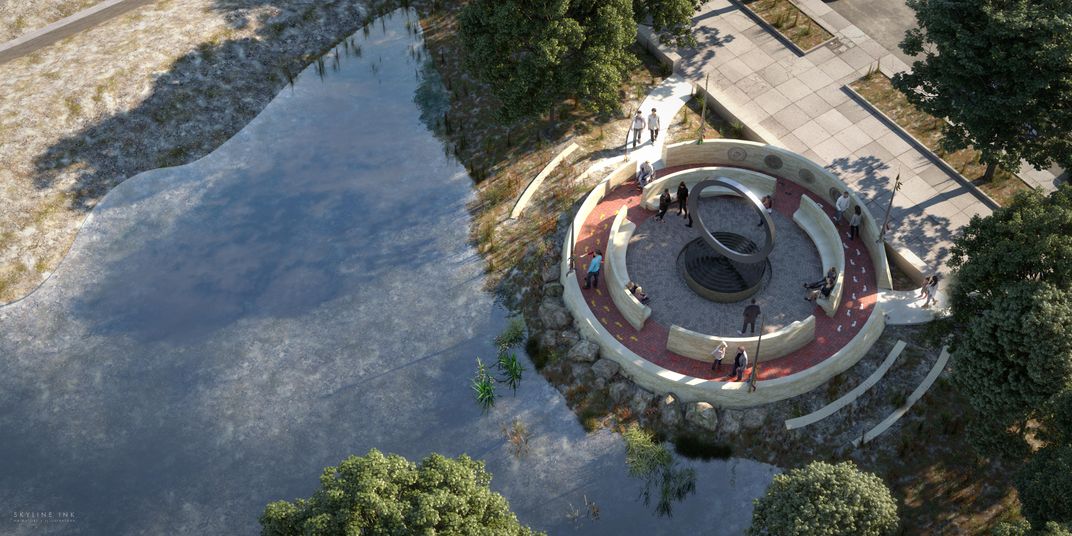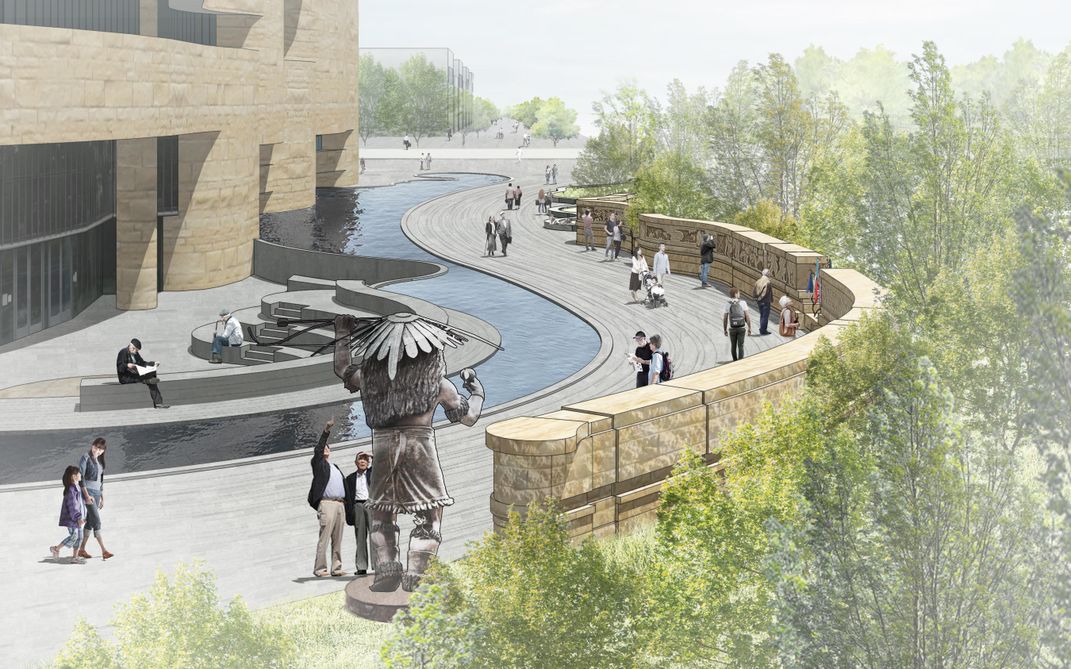This Innovative Memorial Will Soon Honor Native American Veterans
The National Museum of the American Indian has reached a final decision on which design to implement
/https://tf-cmsv2-smithsonianmag-media.s3.amazonaws.com/filer/22/77/2277f56b-5e00-49c8-ac12-2f2b2d9aef3e/vetslead.jpg)
UPDATE 6/26/18: The National Museum of the American Indian has just announced its selection of Harvey Pratt’s Warrior Circle of Honor design for its new memorial to Native American veterans, which is expected to grace the National Mall by late 2020. Harvey hopes the memorial he envisioned will become a sacred place for Native Americans everywhere.
“Native Americans have been fighting for this country ever since the Vikings, ever since Columbus,” Harvey says. “Their blood is spilled all over America. Whoever owns this land, it will always be Indian country, and Indians are always going to fight for this land, and for this nation.” His Warrior Circle of Honor will pay tribute to the ongoing sacrifice of Native American peoples all across the country, and offer a place for survivors to come together in commemoration.
Read our original story on Harvey Pratt’s design, and the four others that made it to the final phase of consideration, below.
On Veterans Day 2017, the National Museum of the American Indian made an unexpected but widely acclaimed announcement: it would be soliciting submissions from the public detailing potential designs for a brand-new memorial on the National Mall.
Situated on museum grounds, the memorial would be dedicated to the spirit, bravery and sacrifice of Native American soldiers across United States history, and would serve as a place of solace and communion for Native American veterans and their loved ones.
Now, the submission period has closed, and the museum has winnowed the pool of designs down to five possibilities. Detailed concept art of the finalist submissions went on view at both of the museum’s locations in New York City and on the National Mall in Washington, D.C. Each prospective memorial approaches the narrative of Native American military personnel in a distinct way, and any would make for a beautiful, thought-provoking addition to the National Mall.
The museum is inviting outside comment from the community through June 12, 2018, as it makes its decision—the winning design will be announced in the months to come.
For your consideration, here are the five finalist designs:
Wellspring of Valor

In developing his concept for the new memorial, James Dinh took care to balance American military iconography with Native American iconography, setting symbols and the traditions they represent in intimate conversation with one another.
At the center of Dinh’s design is situated a tranquil “healing fountain,” surrounded by a quintet of tall glass spires. Labeled respectively with the values of Valor, Honor, Pride, Devotion and Wisdom, their glistening angular forms unite when seen from above to form a five-pointed star.
That this star has a void at its heart—where the healing fountain is situated—speaks to the cost of battle. “Those who died in the line of duty are marked by the empty space at the center of the star,” Dinh says in his artist’s statement, “which is illuminated at night to memorialize the courageous lives of these men and women.”
Concentric circles—“ripples,” in Dinh’s imagination—radiate outward from the star and fountain, and are bounded on one side by a mound of earth evocative of the ancient lifestyle of America’s Mound Builder peoples. Inlaid in this mound is a firm stone wall bearing testimonial quotes from Native American servicemen and women. “Like a slice through the earth,” Dinh says, “the stone wall inscribes the individual voices of veterans that are often collectively buried within history.”
One stretch of this wall, which Dinh terms the “Wall of Stories,” is particularly striking—that featuring a seated bronze sculpture of a Native American mother and child. Visitors would be invited to sit alongside the sculpture to contemplate in a moment of peace the hardships weathered by countless Native American families as a result of war.
Warriors’ Circle of Honor

Another memorial proposal featuring a prominent centerpiece is that of Harvey Pratt, which eschews the military emphasis of the star symbol at the core of Wellspring of Valor in favor of a simpler geometric form: the circle. A fixture in much Native American storytelling, the symbol of the circle—rendered in Pratt’s design in gleaming stainless steel—suggests the cycle of life and death, and the continuity of all things.
“On ceremonial occasions,” Pratt says, “a flame will be ignited at the base of the circle. Veterans, families and others are invited to ‘come to the campfire’ and tell their stories.” By situating the memorial to look out over the stillness of the nearby Chesapeake Bay wetland landscape, Pratt hopes to foster an environment of peaceful contemplation in which visitors can come together over the stories of those who have served—and share their own.
This storytelling space, which offers four arcing benches to visitors, is the inner of two concentric circles—beyond it lies a redbrick walkway, on which museumgoers can wander at their own pace and immerse themselves in the circular symbolism. Along this walk, symmetrically spaced, are four lances jutting skyward. While clearly emblematic of military courage, the lances serve another purpose: guests who wish to leave their mark on the memorial are invited to tie prayer cloths to them.
Beneath the steel circle, which Pratt calls the "Sacred Circle," is an “intricately carved stone drum,” which will convey the constant pulse of Native American spirit and sacrifice across the breadth of America’s history. It is not strictly somber in its symbolism, however—Pratt hopes visitors will seize on the silent rhythms of the memorial as an invitation to harmonize their experiences. “The drumbeat,” he says, “is a call to gather.”
We Fought for Our Country

Daniel SaSuWeh Jones and Enoch Kelly Haney’s contest submission is also geared toward community experience, and the notion of making the stories of Native American heroes accessible to all. While humble in size, Jones and Haney’s memorial is situated near the museum to catch the eyes of as many guests coming and going as possible, inviting spontaneous conversation and opportunities for photographs.
We Fought for Our Country takes the form of a squat cylindrical plinth—whose rough-hewn marble echoes the coloration of the museum overlooking it—surmounted by a sculpture of two Native American figures captured mid-footstep. The taller figure, an adult woman shepherding a child along her path, represents nature, in all its constancy and grace. Her traveling companion, a little girl, is a personification of the future.
Stones from Oklahoma’s Chilocco Indian Boarding School, the alma mater of a great many 20th-century Native American soldiers, line Nature and Child’s path, suggesting the ceaseless yet often unacknowledged sacrifices of members of America’s indigenous communities.
Below this elevated pair, a group of faceless additional figures keeps watch in a circular formation—“six bronze Guardians,” the designers say, “representing spirit protectors of Nature and Child.” The uniforms on these bronzes correspond to the different branches of the U.S. military, while the headdresses they wear pay homage to the various major indigenous groups of America.
Farther down the column are plaques depicting the “US Military/Indian relationship with scenes of valor, endurance and sacrifice,” and a circle of eight-inch bronze figures holding hands in solidarity, camaraderie and communal oneness. A final, poignant element of the memorial is the Healing Hand, a bronze hand that invites visitors to reach out physically and put themselves in communion with Nature, Child and their Guardians.
The Enduring Dance

This concept, proposed by Stefanie Rocknak, shares with We Fought for Our Country a sense of dynamism and a deliberate blend of military and Native American dress. Where Haney’s piece elevates two symbolic figures, however, Rocknak’s sets an assortment of nine essentially side-by-side, so as to suggest a coming-together and a celebration of shared legacy. This joyous quality of the memorial is strengthened by Rocknak’s decision to present nearly all of the sculptures (“cast in bronze and finished with a granite-like patina”) as dancers in the midst of ritual performance.
Eight of the nine figures, whose diverse attire signals both wide-ranging heritage and commonality in the warrior tradition, are situated atop a small wall, inscribed on its face with textual narrative detailing the deep history of Native American service and selflessness. Rocknak says that this text will “encompass the obstacles, the achievements, and the continuation of the warrior tradition from generation to generation.”
Standing between the wall and the viewer is the interpretive figure of the Storyteller, a sculpture whose simple windblown robes suggest a kind of timelessness. She mediates between the dancing warriors behind her and the visitors eager to learn those warriors’ stories and perhaps to share their own. “Her visage will be wise, calming and eternal,” says Rocknak. “The visitor can almost hear her even-toned voice as it resonates throughout the ages.”
Driving home the storytelling focus of Rocknak’s memorial is the nighttime lighting of the figures, which dances on their stony faces so as to evoke a deeply personal fireside discussion. “The front of the sculptures will be illuminated with an amber light, which will flicker,” Rocknak says, “and so be suggestive of the glow of a ceremonial fire.”
Ribbon of Time

The final concept under consideration is Leroy Transfield’s Ribbon of Time, a sinuous stone wall that charts pictorially and via direct quotes the history of Native American service across the most tumultuous periods in global history. Transfield has proposed that the memorial be situated along the northern face of the museum, such that its own arcing form will mirror that of both the museum’s long river-like fountain and its undulating limestone exterior.
Transfield’s design might call to mind Maya Lin’s famed Vietnam Veterans Memorial, but the two walls are miles apart in their messaging. Where Lin’s cold black tribute, pointed like a chevron and reflective so as to implicate and confront viewers, suggests the weight of loss and the tragedy of dehumanization in war, Transfield’s tribute to Native American veterans envelops visitors in its welcoming recesses and tells them inspirational stories, celebrating the human bravery of individuals rather than mourning them en masse.
At the end of the wall, and the end of the meandering story, a towering sculpture of a proud Native American warrior keeps watch, looking out over the memorial and fountain and to the Washington Monument rising far beyond. His presence visually links the Native American experience etched in the stone of the wall with the broader American experience represented by the open National Mall.
The memorial will “blend and harmonize with the surrounding [landscape] as if it has always been a part of it,” Transfield says, “as if it has risen from the earth—a sort of ancient ruin that tells a great cultural story honoring the indigenous veterans of this land.”
Plans for the five designs are on view at the Smithsonian's National Museum of the American Indian in the the exhibition "National Native American Veterans Memorial Design Competition" in Washington, D.C. and in New York City at the Alexander Hamilton U.S. Custom House, One Bowling Green, through May 30, 2018. Comments are being accepted via email through June 12.
/https://tf-cmsv2-smithsonianmag-media.s3.amazonaws.com/accounts/headshot/DSC_02399_copy.jpg)
/https://tf-cmsv2-smithsonianmag-media.s3.amazonaws.com/accounts/headshot/DSC_02399_copy.jpg)